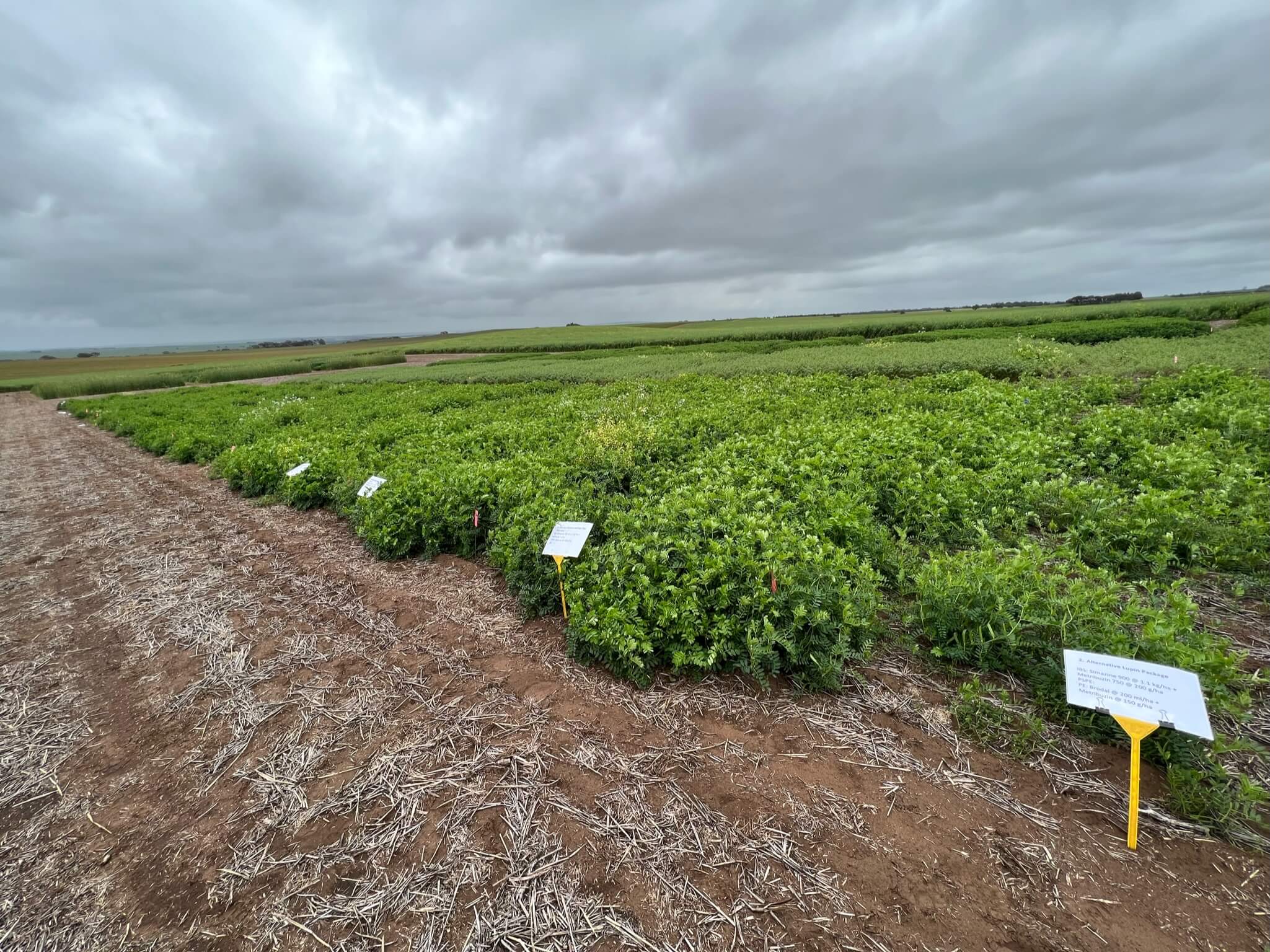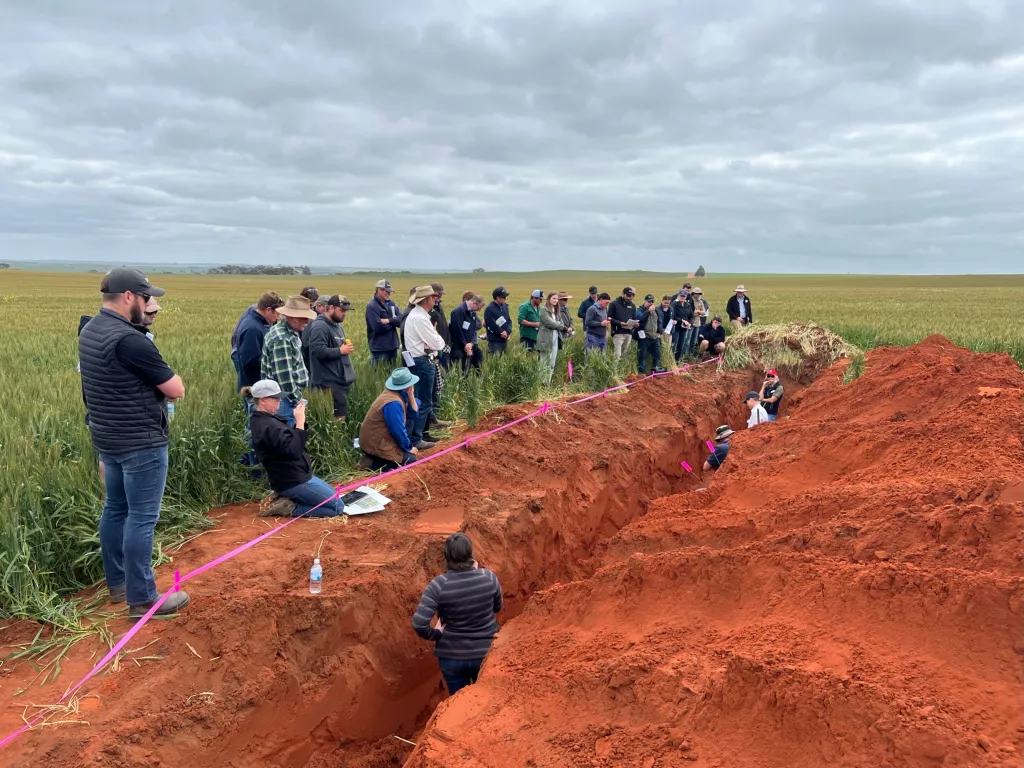Exploring Effective Herbicide Packages for Lupin, Chickpea & Vetch
By Nathan Craig, Chief Executive Officer & Melanie Dixon, Mixed Farming Systems Officer
Key Messages
The trial outcomes distinctly highlight the variable responses of lupins, chickpeas, and vetch to uniform herbicide treatments. This variability underscores a critical gap in current agronomic practices – the need for herbicide regimes tailored to each legume species. A one-size-fits-all approach to herbicide application is suboptimal. By developing species-specific herbicide strategies, growers can more effectively manage their crops, leading to improved health and yield.
Background
Grain legumes have been widely grown in Western Australia, with lupins the most dominant species due to their suitability to acidic sandy soils. Although high value pulses may not be suited to all soil types and regions, there are areas of WA (soil type x environment) where they are highly suited. Despite this, the adoption of grain legumes in these areas has been poor and the proportion of pulses in the farming system is suboptimal and in fact declining. There has also been a stagnation of lupin yields. Since the inception of GRDCs Western Regional Cropping Solutions networks (now GRDC Grower Networks), growers have continually highlighted that there are no specifically adapted or consistently profitable break crops/legume options for their farming systems. Research is ongoing to select for acid and chilling tolerant crop species which will expand the areas where grain legumes can reliably be grown in WA. However even with existing species and cultivars, there are rotational and economic advantages from incorporating grain legumes into the farming system that are not being realised.
Aim
This trial investigated the weed control effectiveness of a range of herbicide packages for lupin, chickpea, and vetch to demonstrate that effective weed control options are available for chickpea and vetch.
Methods
A replicated trial site was established on a deep sandy soil type in the West Midlands region of Western Australia. The replicated plot trial comprised three crop species, with lupins serving as the standard grower legumes, and chickpea and vetch selected as alternative legumes for the region (Table 1). The purpose of the trial was to assess the efficacy of a range of best practice herbicide packages across each species (Table 2), and to assess the impact of incorrect application to each crop species and the impact of post-emergent herbicide application. Throughout the season, various measurements were taken to evaluate legume growth, herbicide damage, nodulation, and weed control efficacy.
Trial Design & Treatments
Table 1: General site details

Table 2A: Species

Table 2B: Herbicide Package Treatments. All rates are expressed per hectare.


Results
The trial commenced on soil without prior amelioration, with wheat stubble from the previous year and evidence of cattle grazing. The pre-sowing weed competition was not quantified; however, post-sowing observations indicated a moderate weed burden.
The trial was sown on the 24th of May 2023.
Rainfall & Temperature
Table 1: Monthly Rainfall (mm) and Mean Temperature at closest weather station (Badgingarra) throughout 2023.

Plant Establishment & Weed Populations

Plant establishment (plants/m2) varied between each crop species due to the different target plant density for each crop but was also affected by the herbicide package (Treatment) used (Figure 1). For each species, the herbicide package that was most suited to the species resulted in the highest plant establishment for each crop type. Plant establishment for vetch was very low where the alternative lupin package was used (Treatment 2) while lupin establishment failed where the Vetch herbicide package was used (Treatment 4).
Weed density (total population, plants/m2) was less than 5 plants per square metre across nearly all herbicide packages (Treatments) used (Figure 2). As a rule, weed density tended to be higher for lupin than chickpea or vetch, with weed densities in lupin being highest where chickpea or vetch herbicide package were used (Treatment 3,4), or where no post-emergent lupin herbicides were used (Treatment 5).

Herbicide Damage Assessment

Visual assessment of herbicide damage for all crop species varied considerably when measured on the 24th of August following post-emergent application on the 21st of June (Figure 3). Herbicide damage was greatest in the treatments that had post emergent herbicide applications (Treatments 1-4) and within these, herbicide damage was greatest where the herbicide package was applied to the alternate crops (i.e. when lupin herbicide package was applied to chickpea or vetch for example). Nodulation was also assessed for all crop species on the 24th of August, with lupin nodulation severely reduced where herbicide package 3 and 4 (chickpea and vetch package) were used, and chickpea and vetch nodulation tended to be lower where post emergent herbicides were applied (Figure 4, Treatment 1-4).
Nodulation Score

Crop Biomass

August Biomass highlights significant variation across herbicide treatments among the three legume species (Figure 5). Chickpea and Vetch performed poorly under Treatments 1 and Treatment 2. In most treatments Lupins outperformed Chickpea and Vetch in August dry matter production, with the exceptions of Treatment 3, Treatment 4 and Treatment 7 which were chickpea, vetch, and chickpea herbicide packages (respectively). Biomass at this crop stage was generally the inverse of herbicide damage and biomass measurements were taken to quantify the impact of herbicide damage.



The trend in reduction of biomass across herbicide packages (Treatments) continued into plant maturity biomass (dry matter) which were taken on the 4th of October (Figure 6). Lupin tended to have the highest biomass production across all crop types and treatments, with the exception of Treatments 3 and 4. The use of herbicide packages not suited to crop species had the greatest impact on biomass production, with post emergent application of chemicals having the greatest impact on biomass production.

Grain Yield

Grain Quality and Yield Measurements were completed by mechanical harvest on the 17th November (Figure 7). There were some plots that were difficult to harvest as there was insufficient grain produced where biomass production was extremely low (for example, lupin in Treatment 3 and 4). Lupin grain yield was greater than 2.5 t/ha across all treatments, with the exception of Treatment 3 and 4, and chickpea grain yield varied between 1.8 to 2.2 t/ha where there was little herbicide damage, and 0.8 to 1.4 t/ha where biomass was reduced.
Conclusions
There are three main highlights in this trial that are of benefit to growers when considering growing a grain legume. The first is that effective weed control was achieved in chickpea and vetch relative to lupin, where in some instances, weed control was more effective than in lupin. Part of this was related to lower crop competition by lupin where there was significant herbicide damage that restricted lupin growth and its ability to compete with the main weeds at the site (Annual Ryegrass and Wild Radish). This result is in contrast to current grower perception of the efficiency of legume herbicide options currently available, and from similar trials in the West Midlands area. The difference between these earlier trials and this trial was in the use of best practice herbicide packages that were tailored to each crop species, as guided by Harmohinder Dhammu and Mark Seymour (2023) during the design stage of the trial. This has highlighted the importance for growers to seek qualified advice and consultants who have experience in growing these alternate legume crops, although lack of knowledge in herbicide use for alternate legume crops has been acknowledged. This trial can serve as a starting point for growers to tailor herbicide packages for their own situation, and it is recommended that growers take a long-term approach to growing alternate legumes such as chickpea as it can take 3 years to improve grain yield and management of chickpea.
The second highlight was the importance of using species-specific herbicide treatments as lupin, chickpea, and vetch are all susceptible to the effects of herbicide application from other packages. In particular, the use of a lupin herbicide package (Treatment 1 and 2) on chickpea or vetch, while not leading to outright failure, decreased biomass production and grain yield at the end of the season. The use of chickpea herbicide package on lupin did result in crop failure, although this is unlikely to be a scenario that growers could face as the most popular legume and herbicide package use is lupin. The use of post-emergent herbicides across all species tended to cause the greatest crop damage for all crop species, as indicated by the difference in grain yield (and variability) between Treatments 1-4 and 5-8. The difference between these groups of treatments was that the post-emergent herbicide was omitted from each package. It is important that when growers do trial a new legume such as chickpea or vetch that they ensure farm workers understand the importance of applying the correct herbicide to each crop type to avoid crop failure, especially from post-emergent herbicide application.
The third highlight in this trial was that chickpea with a best practice chickpea herbicide package (Treatment 3) resulted in effective weed control and achieved a grain yield of between 1.8 and 2.2 t/ha, depending on herbicide package used. This grain yield was lower than the range of lupin grain yield (excluding severe herbicide damage) but still achieved a high grain yield for a low rainfall year. This indicates that chickpea do have the potential to perform in the WA Wheatbelt with the current range of varieties and agronomic packages. In this trial, a late rainfall event of 36mm during flowering was too late to improve lupin grain yield but was ideal for chickpea flowering and grain fill in a decile 1 rainfall year. The elasticity of chickpea to take advantage of late seasonal rainfall has been shown in the region in many previous trials and can be further improved by the use of early and/or deep seeding.

Future activities in this project will focus on establishing demonstration sites to showcase the efficacy of species-specific herbicide treatments in grain legumes. The demonstration sites aim to support the broader adoption of diverse legume species by providing clear, evidence-based management strategies. This effort is expected to contribute to the diversification of crop rotations within Western Australian farming systems, enhancing their sustainability and resilience.
More Information
More information about this project can be found on the Grain Legumes Project page.












